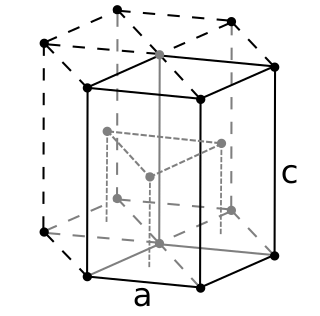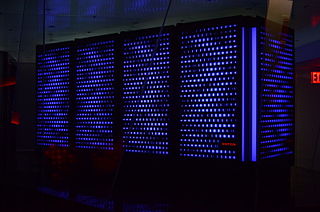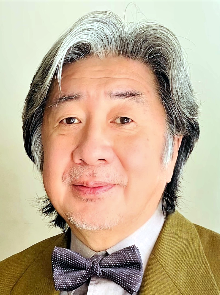Related Research Articles

Nihonium is a synthetic chemical element with the symbol Nh and atomic number 113. It is extremely radioactive; its most stable known isotope, nihonium-286, has a half-life of about 10 seconds. In the periodic table, nihonium is a transactinide element in the p-block. It is a member of period 7 and group 13.
In computing, floating point operations per second is a measure of computer performance, useful in fields of scientific computations that require floating-point calculations. For such cases, it is a more accurate measure than measuring instructions per second.

Yoshio Nishina was a Japanese physicist who was called "the founding father of modern physics research in Japan". He led the efforts of Japan to develop an atomic bomb during World War II.
Riken is a large scientific research institute in Japan. Founded in 1917, it now has about 3,000 scientists on seven campuses across Japan, including the main site at Wakō, Saitama Prefecture, just outside Tokyo. Riken is a Designated National Research and Development Institute, and was formerly an Independent Administrative Institution.
MDGRAPE-3 is an ultra-high performance petascale supercomputer system developed by the Riken research institute in Japan. It is a special purpose system built for molecular dynamics simulations, especially protein structure prediction.

Anton is a massively parallel supercomputer designed and built by D. E. Shaw Research in New York, first running in 2008. It is a special-purpose system for molecular dynamics (MD) simulations of proteins and other biological macromolecules. An Anton machine consists of a substantial number of application-specific integrated circuits (ASICs), interconnected by a specialized high-speed, three-dimensional torus network.

RIKEN Brain Science Institute (RIKEN-BSI) was established in 1997 as part of RIKEN, focusing on neuroscience research located in Wakō city, Saitama Prefecture in the greater Tokyo area, Japan. In 2018 RIKEN-BSI has been reorganized as RIKEN Center for Brain Science, a new center under RIKEN. Yasushi Miyashita became the first Director of RIKEN-CBS.The current director is Ryoichiro Kageyama (2021-).
Ununennium (119Uue) has not yet been synthesised, so all data would be theoretical and a standard atomic weight cannot be given. Like all synthetic elements, it would have no stable isotopes.

The K computer – named for the Japanese word/numeral "kei" (京), meaning 10 quadrillion (1016) – was a supercomputer manufactured by Fujitsu, installed at the Riken Advanced Institute for Computational Science campus in Kobe, Hyōgo Prefecture, Japan. The K computer was based on a distributed memory architecture with over 80,000 compute nodes. It was used for a variety of applications, including climate research, disaster prevention and medical research. The K computer's operating system was based on the Linux kernel, with additional drivers designed to make use of the computer's hardware.

Japan operates a number of centers for supercomputing which hold world records in speed, with the K computer becoming the world's fastest in June 2011. and Fugaku took the lead in June 2020, and furthered it, as of November 2020, to 3 times faster than number two computer.

Masao Ito was a Japanese neuroscientist, and director of the Riken Brain Science Institute.

Viscount Masatoshi Ōkōchi was a Japanese physicist and business executive. He was the third director of the Riken Institute, a position which he assumed in 1921 and held for 25 years. During this period, he was notable for establishing the Riken Konzern, a zaibatsu of companies which focused on utilizing Riken's research results to produce commercial products.

Yoshiki Sasai was a Japanese stem cell biologist. He developed methods to guide human embryonic stem cells (hESCs) into forming brain cortex, eyes, and other organs in tissue culture. Sasai worked at the Riken Center for Developmental Biology (CDB) in Kobe, and was Director of the Laboratory for Organogenesis and Neurogenesis. Following his involvement in the 2014 STAP cell controversy, Sasai was found dead at Riken from an apparent suicide.
Haruko Obokata is a former stem-cell biologist and research unit leader at Japan's Laboratory for Cellular Reprogramming, Riken Center for Developmental Biology. She claimed in 2014 to have developed a radical and remarkably easy way to generate stimulus-triggered acquisition of pluripotency (STAP) cells that could be grown into tissue for use anywhere in the body. In response to allegations of irregularities in Obokata's research publications involving STAP cells, Riken launched an investigation that discovered examples of scientific misconduct on the part of Obokata. Attempts to replicate Obokata's STAP cell results failed. The ensuing STAP cell scandal gained worldwide attention.
Stimulus-triggered acquisition of pluripotency (STAP) was a proposed method of generating pluripotent stem cells by subjecting ordinary cells to certain types of stress, such as the application of a bacterial toxin, submersion in a weak acid, or physical trauma. The technique gained prominence in January 2014 when research by Haruko Obokata et al. was published in Nature. Over the following months, all scientists who tried to duplicate her results failed, and suspicion arose that Obokata's results were due to error or fraud. An investigation by her employer, RIKEN, was launched. On April 1, 2014, RIKEN concluded that Obokata had falsified data to obtain her results. On June 4, 2014, Obokata agreed to retract the papers. On August 5, 2014, Yoshiki Sasai—Obokata's supervisor at RIKEN and one of the coauthors on the STAP cell papers—was found dead at a RIKEN facility after an apparent suicide by hanging.

Jaw-Shen Tsai is a Taiwanese physicist. He is a professor at the Tokyo University of Science and a team leader of the Superconducting Quantum Simulation Research Team at the Center for Emergent Matter Science (CEMS) within RIKEN. He has contributed to the area of condensed matter physics in both its fundamental physical aspects and its technological applications. He has recently been working on experiments connected to quantum coherence in Josephson systems. In February 2014, he retired from NEC Corporation, after 31 years of employment. He is a fellow of the American Physical Society as well as the Japan Society of Applied Physics.
The Quantitative Biology Center (QBiC) is a Strategic Research Center of the Japanese national research and development institute, Riken. In November 2014, they succeeded in making a translucent mouse in order to see its internal organs more clearly.
"Wesenrein" is the 9th episode and midseason premiere of season 4 of the supernatural drama television series Grimm and the 75th episode overall, which premiered on January 16, 2015, on the NBC network. The episode was written by Thomas Ian Griffith and was directed by Hanelle Culpepper.
"Tribunal" is the 10th episode of season 4 of the supernatural drama television series Grimm and the 76th episode overall, which premiered on January 23, 2015, on the cable network NBC. The episode was written by series creators David Greenwalt and Jim Kouf and was directed by Peter Werner.

Fugaku(Japanese: 富岳) is a petascale supercomputer at the Riken Center for Computational Science in Kobe, Japan. It started development in 2014 as the successor to the K computer and made its debut in 2020. It is named after an alternative name for Mount Fuji.
References
- ↑ Ohmura, I.; Morimoto, G.; Ohno, Y.; Hasegawa, A.; Taiji, M. (2014). "MDGRAPE-4: a special-purpose computer system for molecular dynamics simulations". Phil. Trans. R. Soc. A. 372 (2021): 20130387. Bibcode:2014RSPTA.37230387O. doi:10.1098/rsta.2013.0387. PMC 4084528 . PMID 24982255.